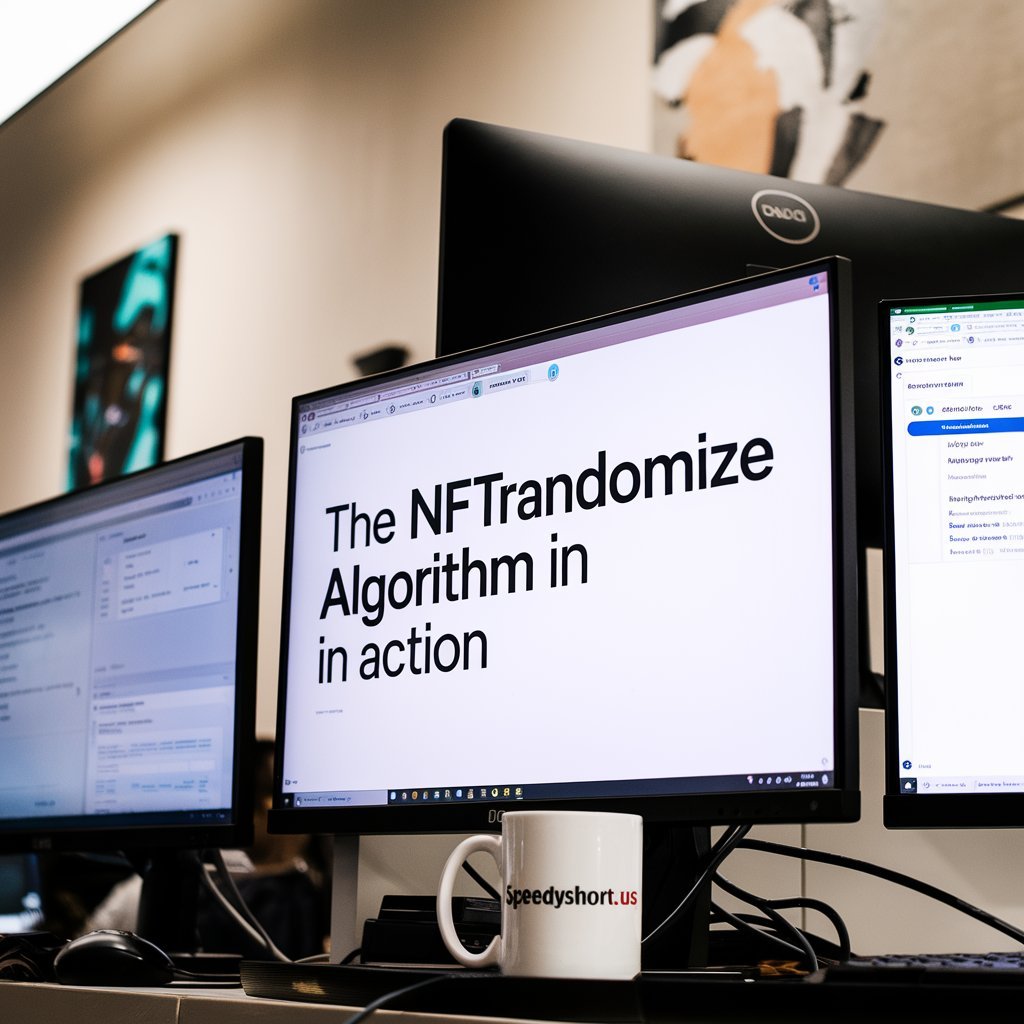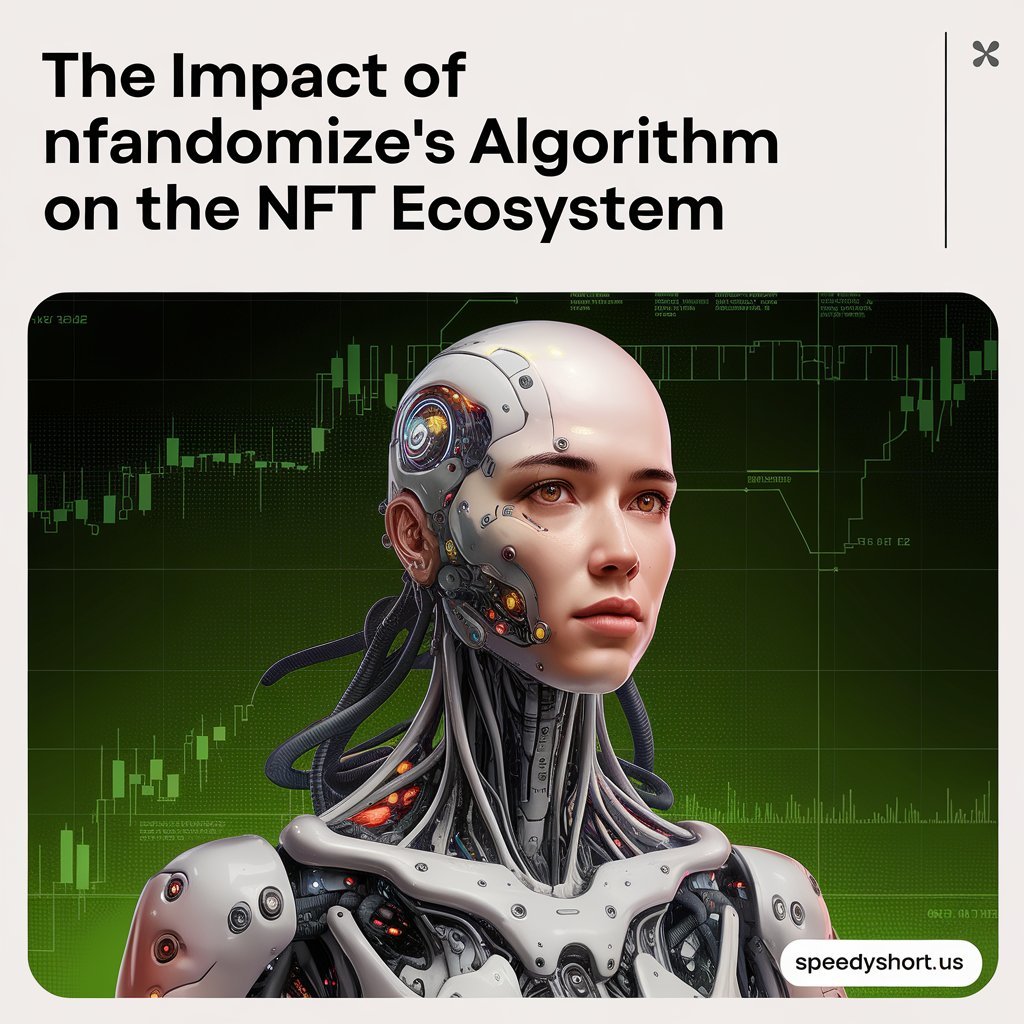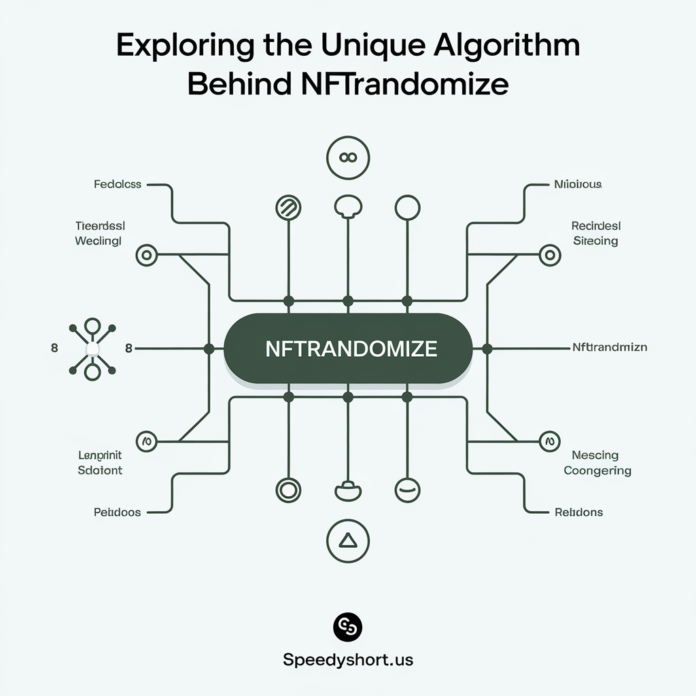Table of Contents
Introduction to NFTRandomize‘s Innovative Approach
In the ever-evolving world of Non-Fungible Tokens (NFTs), NFTRandomize has emerged as a groundbreaking platform that’s revolutionizing the way we think about digital asset creation and distribution. At the heart of this innovation lies a unique algorithm that sets NFTRandomize apart from its competitors. This algorithm, accessible through speedyshort.us, is not just a technological marvel but a game-changer in the NFT space.
The NFTRandomize algorithm represents a significant leap forward in the world of blockchain technology and digital art. By combining advanced cryptography with elements of randomness and user input, NFTRandomize has created a system that ensures each NFT is truly one-of-a-kind. This article will delve deep into the inner workings of this algorithm, exploring its components, benefits, and the impact it’s having on the NFT marketplace.
The Core Principles of NFTRandomize
Randomness as a Foundation
At the core of NFTRandomize‘s algorithm is the concept of true randomness. Unlike many other NFT platforms that rely on predetermined traits or characteristics, NFTRandomize incorporates genuine randomness into every aspect of NFT creation. This approach ensures that each token generated is unique and unpredictable, adding an element of excitement and rarity to the minting process.
The randomness in NFTRandomize is not just superficial; it’s deeply integrated into the algorithmic structure. By utilizing advanced cryptographic techniques and drawing from multiple sources of entropy, the platform creates a level of unpredictability that’s virtually impossible to replicate or game. This foundational principle of randomness sets the stage for all other aspects of the NFTRandomize ecosystem.
User Input and Customization
While randomness forms the backbone of NFTRandomize‘s algorithm, user input plays a crucial role in shaping the final output. The platform allows creators and collectors to interact with the randomization process, providing a unique blend of chance and choice. This interaction can take various forms, from selecting initial parameters to influencing the direction of the generative process.
The beauty of this approach lies in its ability to create NFTs that are both random and personalized. Users can guide the algorithm towards certain themes or styles while still benefiting from the unpredictability that makes each token unique. This balance between randomness and user control is a key factor in NFTRandomize‘s popularity among artists and collectors alike.
Blockchain Integration and Security
NFTRandomize‘s algorithm is deeply integrated with blockchain technology, ensuring the security, transparency, and immutability of each NFT created on the platform. By leveraging the power of distributed ledger technology, NFTRandomize provides a tamper-proof record of each token’s creation and ownership history.
The algorithm interacts with the blockchain at multiple points during the NFT creation process. From generating the initial random seed to recording the final token attributes, every step is securely logged on the blockchain. This integration not only enhances the security of the NFTs but also provides a verifiable trail of their unique creation process, adding to their value and authenticity.
The NFTRandomize Algorithm in Action

Seed Generation and Initial Parameters
The journey of creating an NFT on NFTRandomize begins with the generation of a unique seed. This seed serves as the starting point for the entire randomization process. The algorithm combines multiple sources of entropy to create this seed, including:
- Blockchain transaction data
- User-provided inputs
- Environmental factors (such as timestamp and network conditions)
- Cryptographic nonces
By combining these diverse sources of randomness, NFTRandomize ensures that each seed is truly unique and unpredictable. This seed then becomes the foundation upon which the rest of the NFT’s characteristics are built.
Once the seed is generated, the algorithm establishes a set of initial parameters. These parameters can be influenced by user input, allowing for some degree of customization while still maintaining the element of randomness. These initial parameters might include:
- Color palette ranges
- Geometric constraints
- Thematic elements
- Complexity levels
The interplay between the random seed and these initial parameters sets the stage for the next phase of the NFT creation process.
Iterative Randomization and Pattern Generation
With the seed and initial parameters in place, NFTRandomize‘s algorithm enters an iterative phase of randomization and pattern generation. This phase is where the magic truly happens, as the algorithm creates complex, unique patterns and structures that will form the visual or conceptual basis of the NFT.
The iterative process involves multiple rounds of:
- Random number generation based on the initial seed
- Application of mathematical transformations
- Pattern recognition and enhancement
- Recursive element generation
Each iteration builds upon the previous one, creating layers of complexity and uniqueness. The algorithm employs various mathematical concepts, including fractal geometry, cellular automata, and chaos theory, to generate intricate and aesthetically pleasing patterns.
What sets NFTRandomize apart is its ability to create patterns that are not just random, but also coherent and visually appealing. The algorithm includes checks and balances to ensure that the generated patterns meet certain aesthetic criteria, discarding or modifying outputs that don’t meet these standards.
Attribute Assignment and Metadata Creation
As the visual or conceptual elements of the NFT take shape, NFTRandomize‘s algorithm moves on to the crucial phase of attribute assignment and metadata creation. This step is vital in defining the unique characteristics and properties of each NFT, which contribute significantly to its value and collectibility.
The attribute assignment process involves:
- Analyzing the generated patterns and structures
- Identifying key features and elements
- Assigning rarity scores to different attributes
- Creating a comprehensive set of metadata that describes the NFT
The algorithm uses advanced pattern recognition techniques to identify and categorize various elements within the generated content. These elements are then assigned attributes based on their characteristics, rarity, and relationship to other elements.
NFTRandomize‘s approach to metadata creation is particularly innovative. Instead of using a fixed set of predetermined traits, the algorithm generates dynamic metadata that truly reflects the unique nature of each NFT. This can include:
- Detailed descriptions of visual elements
- Rarity scores for different attributes
- Historical data about the creation process
- Embedded links to related digital content
The resulting metadata is not just a static description but a rich, interactive set of information that enhances the value and interactivity of the NFT.
Final Rendering and Blockchain Minting
The final stage of NFTRandomize‘s algorithm involves rendering the NFT in its final form and minting it on the blockchain. This process transforms the complex set of patterns, attributes, and metadata into a cohesive digital asset ready for distribution and collection.
The rendering process can vary depending on the type of NFT being created. For visual NFTs, this might involve:
- High-resolution image generation
- Application of final visual effects and filters
- Optimization for different display formats
For more conceptual or interactive NFTs, the rendering process might include:
- Compilation of interactive elements
- Generation of 3D models or animations
- Creation of accompanying audio components
Once the NFT is fully rendered, NFTRandomize‘s algorithm initiates the blockchain minting process. This involves:
- Generating a unique token ID
- Encoding all metadata and attributes
- Creating the blockchain transaction to mint the NFT
- Signing the transaction with cryptographic keys
The minting process ensures that the NFT is securely recorded on the blockchain, creating an immutable record of its existence and characteristics. This final step transforms the output of NFTRandomize‘s algorithm from a digital creation into a valuable, tradable asset.
The Impact of NFTRandomize‘s Algorithm on the NFT Ecosystem

Redefining Rarity and Value
NFTRandomize‘s unique algorithm has had a profound impact on how rarity and value are perceived in the NFT market. By introducing true randomness and dynamic attribute generation, the platform has created a new paradigm for assessing the uniqueness and desirability of digital assets.
Traditional NFT platforms often rely on predetermined rarity tiers or limited edition releases to create value. In contrast, NFTRandomize‘s approach ensures that every single NFT minted is inherently rare and unique. This has led to a more dynamic and unpredictable market, where the value of an NFT is determined not just by its edition number but by the truly unique combination of attributes it possesses.
Collectors and investors in the NFTRandomize ecosystem have had to develop new strategies for evaluating and acquiring NFTs. The platform’s algorithm has created opportunities for discovering hidden gems and undervalued assets, as the true rarity of an NFT might not be immediately apparent without a deep understanding of its attributes.
Fostering Creativity and Innovation
The NFTRandomize algorithm has become a powerful tool for artists and creators, pushing the boundaries of what’s possible in digital art and collectibles. By providing a framework that combines randomness with user input, the platform has opened up new avenues for creative expression.
Artists using NFTRandomize have found innovative ways to incorporate the algorithm into their creative process. Some use it as a starting point, generating random elements that they then refine and develop. Others embrace the unpredictability fully, allowing the algorithm to challenge their artistic vision and lead them in new directions.
This algorithmic approach to art creation has led to the emergence of new artistic styles and genres unique to the NFTRandomize platform. Collectors have shown great interest in these algorithm-assisted creations, recognizing them as a new form of digital art that blends human creativity with computational randomness.
Enhancing Transparency and Trust
One of the most significant impacts of NFTRandomize‘s algorithm has been its contribution to transparency and trust in the NFT market. By recording every step of the NFT creation process on the blockchain, the platform provides an unprecedented level of verifiability and authenticity.
This transparency has several important implications:
- Provenance Tracking: The algorithm’s blockchain integration allows for complete tracking of an NFT’s history, from creation to current ownership.
- Fraud Prevention: The unique nature of each NFT generated by NFTRandomize makes it extremely difficult to create counterfeit or duplicate tokens.
- Fair Pricing: The transparent attribute system allows for more informed pricing decisions, based on the true rarity and uniqueness of each NFT.
- Creator Recognition: The algorithm ensures that the original creator of an NFT is always credited, with their contribution permanently recorded on the blockchain.
These factors have contributed to building a more trustworthy and reliable NFT ecosystem, attracting both creators and collectors who value authenticity and transparency.
Driving Technical Innovation
The development and implementation of NFTRandomize‘s algorithm have spurred broader technical innovation in the blockchain and NFT space. The platform’s success has inspired other developers and companies to explore new approaches to NFT creation and management.
Some of the technical advancements influenced by NFTRandomize include:
- Improved Random Number Generation: The need for true randomness has led to advancements in blockchain-based random number generation techniques.
- Enhanced Metadata Standards: NFTRandomize‘s dynamic metadata approach has influenced the development of more flexible and comprehensive metadata standards for NFTs.
- Advanced Visualization Tools: The complex patterns generated by the algorithm have driven the creation of new tools for visualizing and interacting with NFTs.
- Blockchain Scalability Solutions: The high volume of data generated by NFTRandomize‘s detailed NFTs has contributed to the development of more efficient blockchain storage and processing solutions.
These technical innovations have benefits that extend beyond the NFT space, contributing to the broader development of blockchain technology and decentralized applications.
Challenges and Future Developments
Scaling for Growing Demand
As NFTRandomize continues to gain popularity, one of the primary challenges facing the platform is scaling its algorithm to meet growing demand. The complex computations involved in generating truly random and unique NFTs can be resource-intensive, potentially leading to slower minting times or increased costs.
To address this challenge, the NFTRandomize team is exploring several solutions:
- Optimized Algorithms: Continuously refining the algorithm to improve efficiency without sacrificing randomness or complexity.
- Parallel Processing: Implementing parallel computing techniques to handle multiple NFT generations simultaneously.
- Layer 2 Solutions: Exploring the use of Layer 2 blockchain solutions to reduce congestion on the main network and lower transaction costs.
- Cloud Computing Integration: Leveraging cloud computing resources to handle spikes in demand and ensure consistent performance.
These scaling efforts are crucial for maintaining NFTRandomize‘s position as a leading innovator in the NFT space and ensuring that the platform can continue to meet the needs of its growing user base.
Evolving the Algorithm for New Use Cases
While NFTRandomize‘s algorithm has proven highly effective for creating unique digital art and collectibles, the team behind the platform is constantly exploring new use cases and applications for their technology. Some potential areas of expansion include:
- Interactive NFTs: Developing algorithms that can generate NFTs with interactive elements, allowing for dynamic user engagement.
- Generative Music and Sound: Adapting the algorithm to create unique audio experiences, opening up new possibilities for musicians and sound artists.
- Virtual Reality Integration: Exploring ways to use the algorithm to generate immersive 3D environments and objects for virtual reality experiences.
- AI Collaboration: Investigating the potential for combining NFTRandomize‘s algorithm with artificial intelligence to create even more sophisticated and unpredictable NFTs.
- Real-World Asset Tokenization: Adapting the algorithm to help in the creation of unique tokens representing real-world assets, enhancing traceability and ownership verification.
These evolving use cases demonstrate the versatility and potential of NFTRandomize‘s algorithmic approach, suggesting a bright future for the platform beyond its current focus.
Addressing Environmental Concerns
As with many blockchain-based technologies, NFTRandomize faces challenges related to energy consumption and environmental impact. The computational intensity of the algorithm, combined with the energy requirements of blockchain networks, has raised concerns among environmentally conscious users and critics.
In response, NFTRandomize is taking several steps to address these concerns:
- Efficient Algorithm Design: Continuously optimizing the algorithm to reduce its computational requirements without compromising on randomness or uniqueness.
- Green Blockchain Integration: Exploring partnerships with more energy-efficient blockchain networks that use consensus mechanisms like Proof of Stake.
- Carbon Offsetting: Implementing a carbon offsetting program to neutralize the environmental impact of NFT creation and transactions on the platform.
- Education and Transparency: Providing clear information to users about the environmental impact of their activities on the platform and offering guidance on how to minimize this impact.
By proactively addressing these environmental concerns, NFTRandomize aims to ensure the long-term sustainability of its platform and contribute to the overall eco-friendliness of the NFT ecosystem.
Conclusion: The Future of NFTRandomize
As we look to the future, it’s clear that NFTRandomize‘s unique algorithm will continue to play a significant role in shaping the NFT landscape. The platform’s commitment to true randomness, combined with its innovative approach to user interaction and blockchain integration, positions it at the forefront of the next generation of digital asset creation and management.
The impact of NFTRandomize extends far beyond just creating interesting or valuable NFTs. It’s driving innovation in blockchain technology, inspiring new forms of digital art, and challenging our understanding of ownership and value in the digital age. As the platform continues to evolve and address challenges, it has the potential to unlock even more exciting possibilities in the world of NFTs and beyond.
For creators, collectors, and technology enthusiasts alike, NFTRandomize represents a fascinating glimpse into the future of digital assets. Its algorithm is not just a tool for creating unique tokens; it’s a catalyst for a new era of digital creativity and ownership. As the platform continues to grow and evolve, it will undoubtedly play a crucial role in defining the future of the NFT ecosystem and the broader world of blockchain technology.

